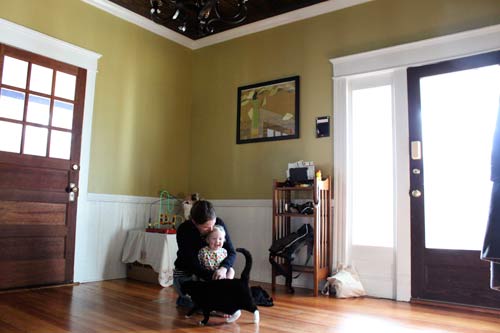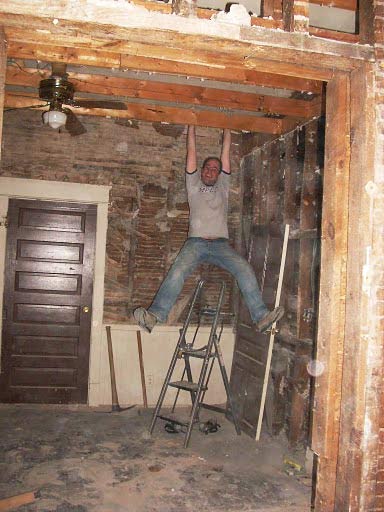By Anita Rao
UNC Staff writer
The Durham VOICE
thedurhamvoice@gmail.com
When 31-year-old Natalie Spring moved into a small house in the Cleveland-Holloway neighborhood in 2002, her friends, family and neighbors all thought she was crazy.

Relaxing with her two-year-old daughter, Madeline, in the front room of her Cleveland-Holloway home, 31-year-old Natalie Spring said she enjoys the natural light that enters through the windows. She and her partner, Harris Carpenter, spent 21 months renovating the house and did a lot of work in this room to fix the walls, ceiling and floor. (Staff photo by Anita Rao)
“People thought I was a naive white girl who had gotten into something she didn’t understand,” Spring said.
Looking back on it now, Spring agrees that she didn’t really know what she was getting into. When she moved into the neighborhood, many of the streets in the area were lined with boarded-up houses that had been vacant for many years.
In the early 1900s, when the textile industry in downtown Durham was active, the neighborhood was more vibrant, said 29-year-old Cleveland-Holloway resident Matt Dudek. In the 1940s, however, older families started to move out, industries shut down and many houses were deserted.
From the 1970s to 1990s, slumlords and investors bought up many local properties, said Spring. Slumlords rented out individual rooms for exorbitant prices, and investors would buy and sell large amounts of property to each other solely to make a profit.
“Properties would get traded like trading cards,” Dudek said.
So, when Spring moved into Cleveland-Holloway, there was not much community activity or positive street life.
“Some of our older residents didn’t want to talk to people,” Spring said. “There was a street life, but it wasn’t a vibrant one.”
With many vacant houses, it was easy for street crime and drug trading to continue out in the open, Spring said, especially because police rarely came through the neighborhood. However, things have been changing slowly in the 8½ years that she has lived in the area.
Spring said she and her neighbors noticed that though Cleveland-Holloway is close to downtown and bordered by two historic districts, it was left out of a lot of city planning conversation. So, in 2007, neighbors came together to create the Cleveland-Holloway neighborhood group to advocate for the area.

Swinging in the rafters of the front room of his house in January 2008, Harris Carpenter was in the midst of the first year of renovations of his Cleveland-Holloway home that he shares with his partner, Natalie Spring, and daughter, Madeline. Neither Carpenter nor Spring had much background in restoration work, but during the first three months of renovations, Carpenter did demolition on nights and weekends to prepare the house for big structural changes. (Photo courtesy of Natalie Spring)
“Most of the people that have been around here for two or three decades probably wouldn’t call this neighborhood anything,” Spring said. “But now instead of being this forgotten area by the library, we decided to call ourselves Cleveland-Holloway.”
Since the inception of the neighborhood group, there has been a slow influx of new residents to the area. Spring said that in the past three years the percentage of vacant homes has decreased from 65 percent to 30 percent.
Moving into a home that has been vacant for years takes a substantial amount of restoration and energy, said Spring. In 2007, when she and her partner, Harris Carpenter, moved one street over to their current house, 21 months of renovations were necessary to make the property livable. They changed the height of the ceilings, rebuilt doorways, knocked down walls, put up new drywall, fixed the insulation and foundation, sanded the floors and repainted all of the walls.
When Dudek and his girlfriend, Jessie Gladin-Kramer, moved to Durham in 2008, they were also determined to renovate an abandoned house, even though neither of them had much experience with restoration. They had heard stories about growing community activism in the Cleveland-Holloway area and wanted to be part of the neighborhood.
“We had big visions, but realized we didn’t have the time and natural capacity to learn,” Dudek said.
So while living in their kitchen for six months, they turned to local handymen in the neighborhood to help them out. This allowed them to meet neighbors and help keep money in the community. But Dudek explained that despite the positive intentions of new residents in the area, they must be cognizant of how their renovations are affecting their neighbors.
As more people buy and fix up abandoned properties, the area will become a more costly place to live. Spring said that there is still a wide range of price options available, but new homeowners are also taking steps to counteract gentrification. They want to make sure the neighborhood stays true to its motto of “live, rent, own,” which encourages all types of residents to be a part of this community.
Renter and three-year Cleveland-Holloway resident Estella Bell said that the neighborhood is ethnically diverse but very connected.
“People are learning how to network with each other to help the area grow,” Bell said.
According to Dudek, by figuring out what skills and interests different members of the neighborhood have, neighbors try to connect each other to jobs and training opportunities.
Cliff Dyer, who has lived in the neighborhood for 2½ years, said that to support local residents, the neighborhood has an Underemployed Neighbors Fund. The fund employs Cleveland-Holloway residents to help with community-improvement projects.
“People are trying to be as mindful as possible about their impact,” Dyer said. “It’s a complicated issue, and I can’t pretend to know entirely the impact I’m having by being here, but the best I can do is to be aware of it and behave responsibly.”
Dyer’s girlfriend, Jayme Johnson, said the neighborhood group passes out fliers door to door to make sure that everybody stays informed, even if they are not on the e-mail list. The group has 99 members on its listserv and another 50 active members that attend events and meetings.
But Irene Mason, who has been living in the neighborhood for more than 20 years, said the biggest change she has noticed is that people are cleaning up after themselves and the neighborhood looks nicer.
“I don’t have anything too bad to say about the neighborhood now,” Mason said. “Four or five years ago I did, but it has been cleaned up pretty well.”
With people coming together to invest their time and labor in the upkeep of their local community, Dudek said the city of Durham has also taken notice, helping sponsor park cleanups and tree planting.
“There is nothing that one individual can do to change the whole neighborhood,” Spring said. “But everyone can and must make sure that the whole community feels comfortable and included here.”
For a printer-friendly version of this story, please click here.
One thought on “Cleveland-Holloway, a growing community spirit”
Comments are closed.